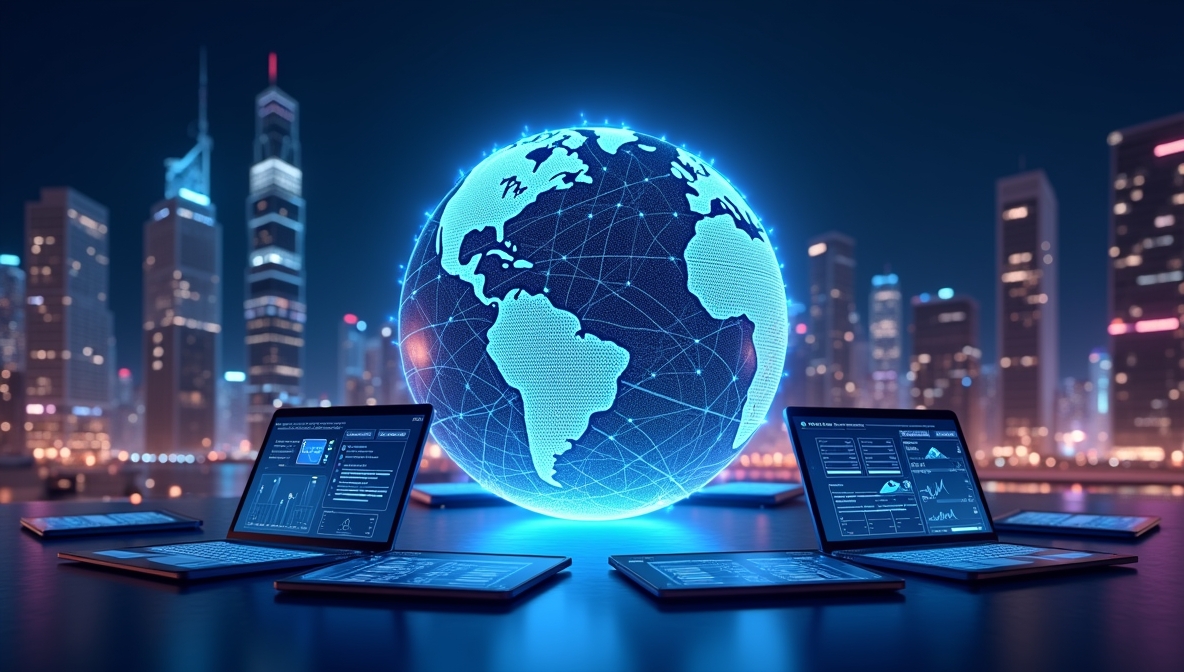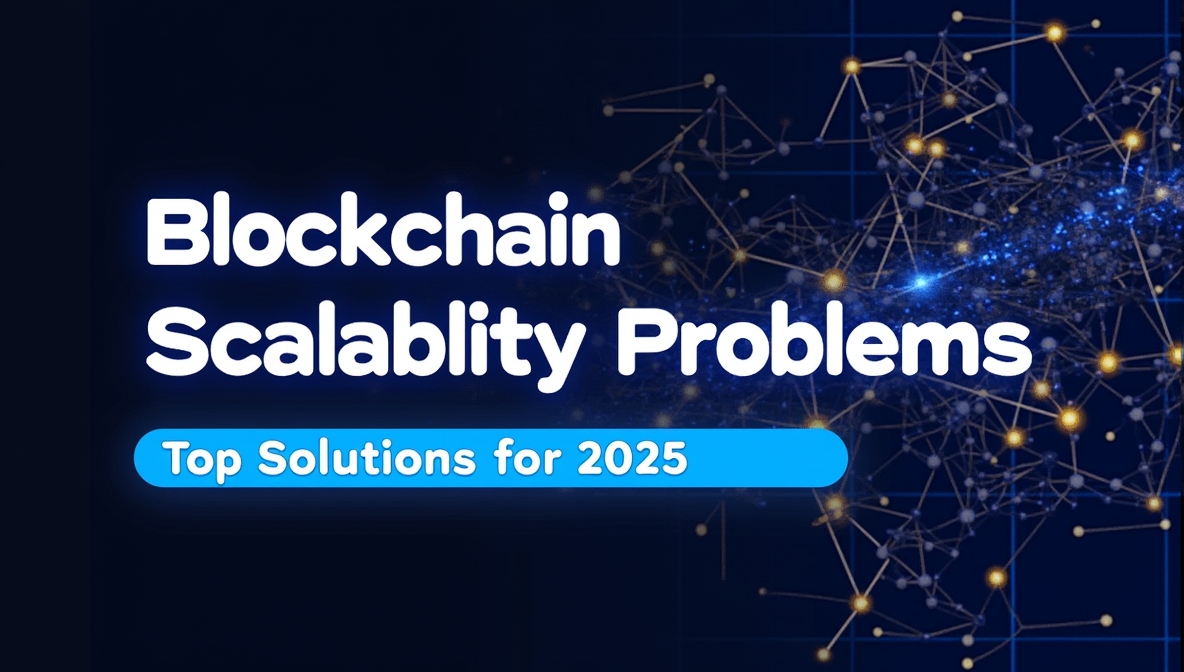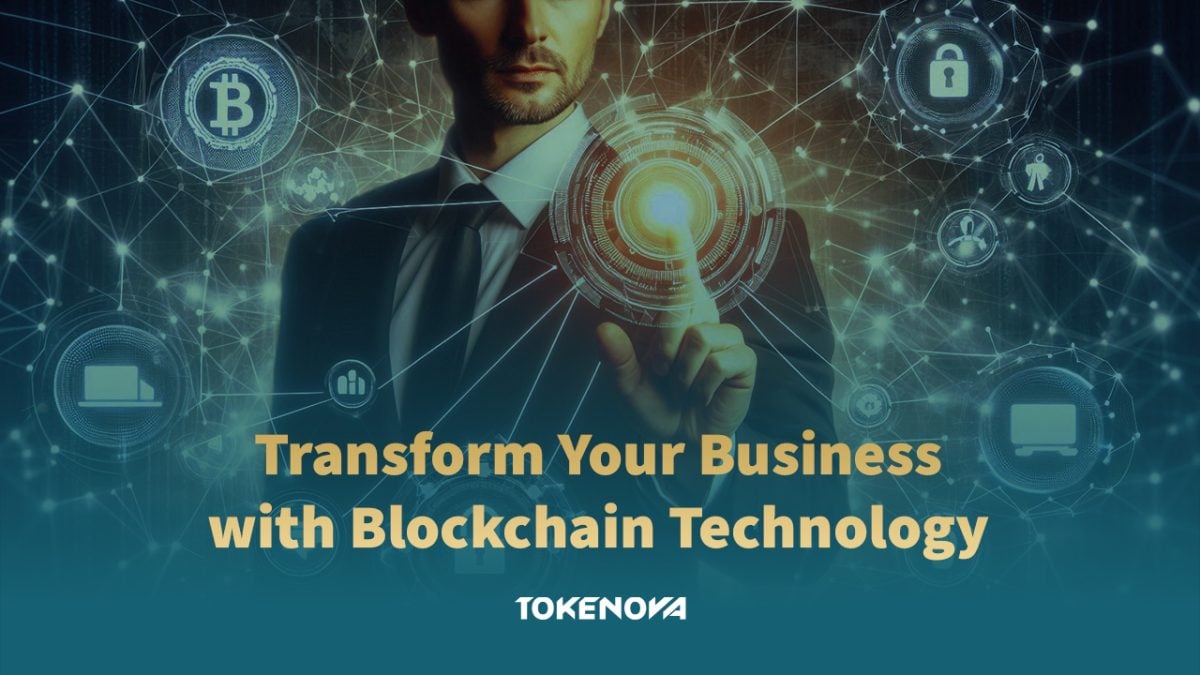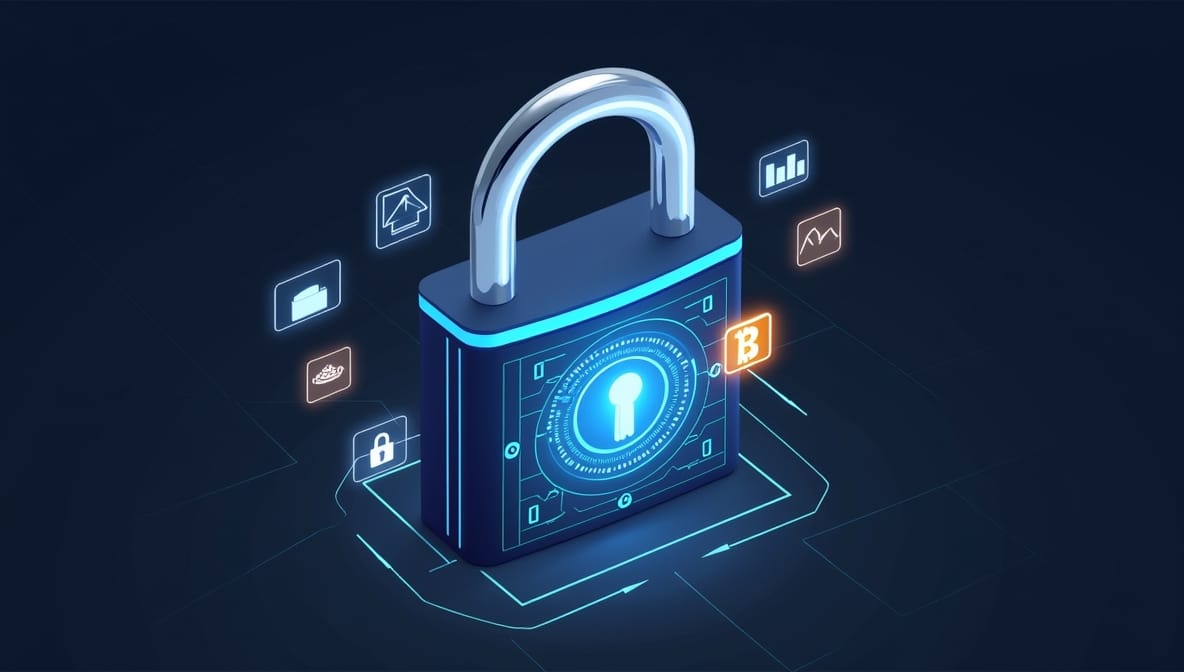Are you curious about how artificial intelligence and blockchain work together to shape the future of secure, intelligent systems? AI and blockchain are increasingly merging, combining advanced data analytics with decentralized ledgers. This powerful duo offers transparent, tamper-proof data management and autonomous decision-making in sectors like finance, healthcare, and supply chains. According to Market US, the Blockchain AI Market is expected to reach USD 2,787 Million by 2033, with 23.1% growth from 2024 to 2033 [1]. This shift will transform centralized models into efficient, democratic networks, enhancing productivity and security by leveraging blockchain’s immutable data.
In this article, we delve into the core architectures and real-world examples that highlight the strength of these technologies when united. We also discuss strategies for businesses eager to harness AI-blockchain, offering insights into technical frameworks and emerging trends set to redefine digital infrastructure beyond 2030. Dive into the full content to discover how these innovations can shape your understanding of the future digital landscape.
Introduction to AI and Blockchain Technology
The integration of Artificial Intelligence (AI) and Blockchain technology is a revolutionary concept that has the potential to transform various industries. Blockchain and AI are two emerging technologies that, when combined, create a secure, transparent, and efficient system. AI’s predictive capabilities and Blockchain’s digital record can enhance data security, authenticity, and integrity. This powerful convergence can lead to new possibilities in areas like supply chain management, healthcare, and finance.
AI excels at analyzing vast amounts of data to identify patterns, make predictions, and automate decision-making processes. On the other hand, Blockchain provides a decentralized, tamper-proof ledger that ensures data integrity and transparency. When these two technologies are integrated, they complement each other’s strengths and mitigate their respective weaknesses. For instance, AI can optimize the efficiency of blockchain networks, while blockchain can provide a secure and transparent framework for AI models.
In managing supply chains, the combination of AI & blockchain can lead to more efficient and transparent operations. AI can predict potential disruptions and optimize logistics, while blockchain ensures the authenticity and integrity of the data. In healthcare, AI can analyze patient data to provide personalized treatment plans, while blockchain secures sensitive medical records. In finance, AI can enhance risk management and data-driven predictions, while blockchain ensures transparent and fair transactions.
The convergence of AI and blockchain technology is not just a theoretical concept but a practical solution to many of the challenges faced by modern industries. As these technologies continue to evolve, their integration will unlock new possibilities and drive innovation across various sectors.
Technical Foundations: Exploring AI and Blockchain
Understanding the technical underpinnings of AI and integrating blockchain is essential for grasping how these technologies work together in practice to enhance trust and transparency in data management processes. Each technology carries its own set of strengths—artificial intelligence for intelligent computation and predictive analytics, blockchain for secure, decentralized record-keeping and trustless environments. Blockchain technologies play a crucial role in enhancing data security, transparency, and efficiency, particularly in sectors like retail and decentralized platforms. When combined, these tools address many shortcomings each faces independently, such as data integrity concerns for AI and scalability challenges in blockchain. Below, we examine their individual foundations to see why the synergy is so potent.
AI: The Engine for Intelligent Computation
Artificial intelligence (AI) uses algorithms and models to process data and simulate human-like decision making. Modern implementations rely on machine learning, neural networks and natural language processing to handle tasks from pattern recognition to automation. Human intelligence drives progress in ML and NLP and enables AI to support business functions and growth through automation and personalization. Despite its obvious potential AI has a trust barrier – many systems especially neural networks are like “black boxes”. The importance of training data in enhancing AI based algorithms cannot be overstated as access to the right training data allows these algorithms to refine themselves in real time. These opaque processes can challenge transparency, accountability and ethics. Centralized AI approaches often struggle with data security as large datasets can be vulnerable to tampering or misuse. [2]
Blockchain: The Distributed Ledger for Trust
Blockchain is a decentralised digital ledger that records data in “blocks” each cryptographically linked to the previous one. This structure makes data records practically immutable once validated by consensus nodes. Key blockchain benefits are:
- Decentralization without relying on a single authority
- Publicly verifiable transactions
- Secure cryptographic validation
- Tamper resistant data storage
Blockchain security is enhanced by using traditional cryptography to verify transactions, ensuring robust protection against unauthorized alterations.
However, blockchains can be slow to scale, and smart contracts often lack the adaptive intelligence needed to handle intricate tasks in dynamic environments. By weaving artificial intelligence into blockchain, these challenges become more manageable, as data-driven predictions and automated optimization can elevate blockchain functionality. Data provenance plays a crucial role in maintaining data trustworthiness within secure and decentralized networks, enhancing large-scale data analytics and facilitating the application of advanced ML models for rapid and secure analysis of on-chain data. [3]
Why the AI-Blockchain Collaboration Matters
Integrating artificial intelligence with blockchain allows for seamless integration, enhancing data security and workflow optimization by combining the strengths of both technologies. Blockchain’s transparent, tamper-proof records resolve data integrity issues that plague AI training, while AI fortifies blockchains with automation, optimization, and predictive capabilities. Additionally, blockchain can enhance the transparency, trust, and security of AI systems by creating a reliable and immutable audit trail for the actions and decisions made by these systems. As we mentioned earlier, the Global Blockchain AI Market is expected to be worth around USD 2,787 Million by 2033 [1]. This synergy could reshape global digital infrastructure. As businesses and governments strive for secure, efficient applications, the joint use of these technologies is poised to reshape global digital infrastructure. Indeed, the fusion of AI and blockchain is increasingly recognized as a foundational model for next-generation innovation.
Blockchain-Enhanced Artificial Intelligence Architectures
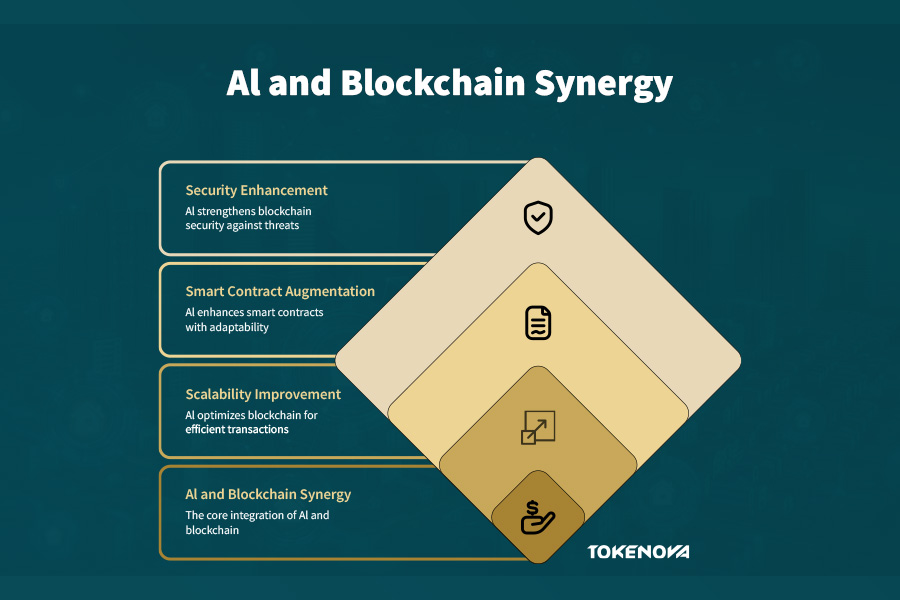
Before we look at the subcomponents it’s important to understand how blockchain’s decentralised frameworks strengthen and secure AI applications. AI and blockchain here means protecting data authenticity, transparent governance for machine learning models and decentralised computational networks. This data management approach is key to future data storage solutions. Blockchain data plays a big role in ensuring data integrity and security, organisations can buy data directly from holders, AI acts as a facilitator to streamline access and usage. Below we will explore the main ways blockchain adds value to AI driven systems.
Data Integrity and Transparency for AI
AI algorithms rely heavily on clean, accurate and unbiased datasets. Using blockchain ledgers to store metadata, timestamps and cryptographic proofs means no one can retroactively alter training datasets. This approach increases trust in AI models by allowing stakeholders to verify the provenance and immutability of the data. The data management process can be optimised and streamlined by AI within blockchain technologies, reducing complexity in traditional methods. For example hashed records can be created for each training batch, combined with digital signatures from verified data providers. Also by combining these technologies users can see into the storage, management and usage of their sensitive data, and the importance of privacy and security. The result is a chain of custody that shows every update or transformation of the dataset. This is critical for highly regulated industries like finance and healthcare where inaccurate or manipulated data could put compliance and patient safety at risk.
Transparent Model Governance
A common criticism of advanced AI is the lack of explainability. By using blockchain organisations can record changes to model parameters, track how data affects outputs and generate a permanent and tamper proof audit trail of transactions. These records give regulators, business partners and customers a verifiable trail of AI evolution. Also blockchain enhances the decision making process by providing immutable records. Blockchain integration means AI can be not just powerful but also transparently governed, allowing compliance with laws that demand accountability and explanation for automated decisions. This transparency goes a long way in showing how artificial intelligence and blockchain work together to build trust in business operations.
Decentralized AI Marketplaces and Compute Power
One of the most exciting concepts is “Decentralized AI” (DeAI). Here, blockchain powers a tokenized economy for buying and selling AI services, datasets and compute power peer to peer. Smart contracts can automate resource allocation: when a user needs compute power to train a large neural network, they can pay tokens to nodes with GPU or CPU capacity. AI agents can collaborate within this decentralized framework to enhance data processing. This democratizes AI development, reduces dependence on centralized data centers. Lots of compute power, fast connectivity and storage is required to fully leverage decentralized AI in areas like science and enterprise. Also storing and sharing data across nodes can help mitigate single points of failure or data breaches and create more robust private AI ecosystems. In many ways this is the ultimate example of the convergence of AI and blockchain to change how we compute on a global scale.
AI-Enhanced Blockchain Systems
Besides blockchain enhancing AI, the opposite is also true: AI brings huge benefits to blockchain networks. By optimizing blockchain transactions AI contributes significantly to the evolution of blockchain. AI also enhances blockchain’s security by providing security and transparency benefits. In the sections below we will explore the main improvements AI can bring to existing ledgers, consensus mechanisms and decentralized applications.
Improving Scalability Through AI
Blockchain has historically struggled with transaction throughput and latency, but AI holds the key to overcoming these challenges. By predicting network congestion and adapting consensus protocols, AI optimizes resource usage, addressing the blockchain scaling challenge. Advanced decentralized learning systems and innovative data-sharing techniques enhance scalability for startups and enterprises within the blockchain ecosystem. Machine learning models analyze user traffic patterns, dynamically adjusting block sizes or reconfiguring node clusters. This results in reduced bottlenecks and more efficient transaction processing. Additionally, AI and machine learning streamline data mining processes, achieving optimized energy consumption and reducing the high energy demands of validating transactions and maintaining blockchain ledgers.
AI-based self-optimization is crucial as blockchains expand to support industries requiring swift settlements, like high-frequency trading. Machine learning techniques applied to consensus algorithms fine-tune mining or validation difficulty in real-time, cutting energy consumption and expediting confirmations. This showcases how artificial intelligence and blockchain work together in real-world scenarios, providing solutions that enhance transaction efficiency and operational effectiveness across various sectors.
AI-Augmented Smart Contracts
Basic smart contracts rely on predefined rules that trigger after certain conditions are met. This rigid structure struggles with complex situations requiring real-time adaptation. By integrating AI, smart contracts become “smart” in the truest sense—capable of ingesting multi-dimensional data, making predictive inferences, and reacting to unpredictable circumstances. AI models embedded in smart contracts enhance the efficiency and security of business processes by automating actions such as resolving disputes and optimizing shipping methods [4].
Natural language processing can parse contract terms, detect ambiguities, or even convert contractual clauses into code. Fraud detection algorithms can scan incoming data for anomalies, halting contract execution if suspicious patterns emerge [5]. In DeFi contexts, AI can dynamically adjust parameters like interest rates and collateral ratios, ensuring stable ecosystems even amid volatile markets. Blockchain technology also facilitates complete transactions by providing a secure and transparent environment for multiple parties to initiate and finalize exchanges of data or financial assets. This expanded functionality underscores the fusion of AI and blockchain as a driver of next-generation financial innovation.
Read More: Ultimate Guide to Smart Contract Security
Advanced Security and Threat Detection
Both AI and blockchain are vital in cutting-edge security strategies. While blockchains provide immutable records, they are not completely immune to sophisticated attacks, such as those targeting smart contract vulnerabilities or user endpoints. AI-driven threat intelligence can spot unusual transaction flows, suspicious contract behavior, or external intrusion attempts in real time [6]. By providing secure and transparent transactions, encrypted data is exchanged within a shared immutable ledger, increasing trust and efficiency. Blockchain enables immediate and transparent sharing of secure data among multiple parties, allowing stakeholders to monitor payments and orders in real time. By combining predictive analytics with anomaly detection organizations can proactively defend their blockchain networks, mitigating hacks before they cause damage. This is especially important as DeFi and digital asset adoption grows and cybercriminals take notice. Advanced cryptographic techniques with AI algorithms can also future proof blockchains against emerging threats like quantum computing, another example of how AI and blockchain work together to secure digital infrastructure.
Big Data Management
The integration of Blockchain and AI is revolutionizing Big Data management by delivering actionable insights and enhancing decision-making processes. AI models analyze historical data to predict trends, while Blockchain ensures data integrity with its decentralized framework.
Key Benefits:
- AI optimizes strategic planning and operational efficiency.
- Blockchain provides a tamper-proof ledger for data security.
- Enhanced trust among stakeholders through transparent records.
- Improved predictive analytics in finance and supply chain management.
In conclusion, the synergy of artificial intelligence and blockchain integration offers a powerful solution for analyzing large datasets, driving innovation, and transforming industries by unlocking new possibilities.
Real-World Implementations
Seeing the integration of artificial intelligence and blockchain in action in real world environments is why this combination is gaining traction in business by improving speed and efficiency. From logistics to finance to healthcare multiple sectors benefit from transparency, predictive insights and decentralized security. The digital landscape is being shaped and transformed by AI and blockchain, enhancing features like automation, customer experience and data security within the current digital environment. Below we explore three use cases that show the impact of combining these technologies.
Read More: Your Essential Guide to register a blockchain-based business
Supply Chain Optimization
Supply chains get transparency and efficiency with AI & blockchain. IoT sensors monitor conditions like temperature, location and humidity during shipping, secure private data. Sensor data is hashed onto a blockchain for tamper proof proof of product integrity. Organizations can buy data directly from data holders, benefit from streamlined access to this data, with AI acting as a gatekeeper to manage and oversee the flow of information. AI algorithms then analyse these streams to predict mechanical failures or routing delays. If certain thresholds are exceeded automated responses – like rerouting goods or adjusting storage conditions – can be triggered. Businesses reduce operational costs and deliver better products, consumers get confidence in product authenticity and environmental conditions. This is how AI-blockchain solve logistics challenges.
Decentralized Finance (DeFi)
DeFi is one of the most prominent areas where artificial intelligence and blockchain come together. Smart contracts eliminate intermediaries, peer to peer lending, trading and other financial services. Adding AI to blockchain enhances the payment process by providing customer insights, streamlining operations and reducing fraud risk. Adding AI to this mix transforms market analysis, risk assessment and strategy optimization.
AI driven trading bots can analyze real-time price data and execute trades, while machine learning models dynamically adjust loan interest rates based on fluctuating liquidity and risk profiles. The result is a more adaptive, transparent and inclusive financial system than traditional banking. Whether through automated portfolio management or advanced credit scoring, how these complementary innovations work together in DeFi is a big change in finance.
Healthcare Data Management
Healthcare deals with huge amounts of private data, so blockchain’s secure, permission-based systems help keep that information safe. Meanwhile AI solutions identify anomalies in medical images, predict disease patterns and personalize treatment plans. Federated learning, a technique that trains AI models without centralizing patient data, can work with a blockchain to coordinate updates from multiple institutions. When combined these solutions enable high quality healthcare analytics that respect data sovereignty, patient consent and regulatory compliance. Healthcare providers get accurate AI powered diagnostics while patients control their data – real proof that AI and blockchain can transform human services.
Future Outlook and Trends
As these technologies continue to advance together, we can expect groundbreaking developments that streamline their combined use. Below, we explore key trends—from next-gen frameworks to autonomous systems and governance innovations—that will shape their collaboration in the future.
Specialized Hardware and Protocols
In order to improve machine learning capabilities in decentralized environments, manufacturers are investigating neuromorphic computing architectures, such as spike-timing-dependent plasticity models and hardware inspired by neurons. With studies indicating that machine learning applications in data centers can reduce energy consumption by more than 40%, these innovations seek to address the energy-intensive nature of current data mining processes. By eliminating the need for sophisticated hardware or in-depth knowledge, such advancements not only increase productivity but also lower barriers to entry for companies. These specially designed solutions are expected to strengthen the role of blockchain integration and artificial intelligence in next-generation computing as they develop.
Self-Sovereign AI Agents
As decentralized infrastructure matures autonomous AI agents may operate independently on blockchains, buying data, renting compute resources and fulfilling tasks for token rewards. These agents will manage entire ecosystems in areas like supply chain or healthcare, negotiating with each other without human oversight. This is a future where AI is truly decentralized and not controlled by big tech, this is how these twin technologies work together to enable new operational models.
Impact on Digital Governance
Decentralized Autonomous Organizations (DAOs) can have AI driven decision systems, reducing human bias and potentially better organizational outcomes. At a governmental level, secure elections and transparent public services can benefit from trusted ledgers, paired with AI solutions for identity verification and resource allocation. Countries that implement such frameworks will give citizens new forms of democratic engagement while increasing trust in public institutions. Through these models we see exactly how this AI-blockchain duo works together to shape governance in the digital age.
Implementation Strategies for Enterprises
Strategic planning is crucial for companies getting ready to implement these technologies. Begin by setting explicit objectives that fit the strengths of intelligent automation and decentralized systems. From there, create a road map focused on security, compliance, and tangible returns. We outline the important actions below for efficiently putting these solutions into practice.
Defining Use Cases and Goals
Begin with defined objectives. What issue are you addressing? Improved security? Smoother processes? Fresh income? Choose the appropriate combination of blockchain (secure tracking) and artificial intelligence (smart analysis) to produce actual outcomes.
Selecting Appropriate Frameworks
Enterprises should choose technologies that fit both AI tasks and decentralized structures. Public blockchains might be suitable for open ecosystems, while permissioned ledgers are often better for sensitive data. AI frameworks need to handle distributed data securely, possibly using federated learning or privacy preserving techniques. Tools that facilitate easy on-chain/off-chain data exchange can simplify development, reducing the complexity of bridging AI computations with blockchain records. Tailor these choices to your organization’s size and risk profile to ensure a successful blockchain and AI integration.
Ensuring Security and Compliance
Regulations vary by industry, so thorough planning is required to ensure compliance. Smart contracts should undergo code audits and AI models should meet data handling standards. Robust governance models can define participant roles, escalation procedures and fail-safes. In cases of personal data, advanced encryption and consent management protocols are essential. Make sure all layers of the architecture meet the relevant regulations to build user trust and lay the foundation for wider adoption of these new systems.
Measuring Performance and ROI
After an AI–blockchain pilot, measuring its impact is key. Key performance indicators (KPIs) might be transaction throughput, cost savings, fraud reduction or decision accuracy improvement. Tangible results will validate the approach and get stakeholder buy-in and funding for larger deployments. Over time as models refine and ledger usage grows, performance metrics should track synergy driven improvements that separate AI–blockchain solutions from traditional systems. Showing how these complementary innovations work together to deliver clear, measurable value is one of the best ways to get ongoing executive and investor support.
Conclusion
AI and blockchain together is a giant leap in digital transformation, combining intelligence with trust-enhancing ledgers. Together they solve problems neither can solve alone – from verifying AI training data to optimizing blockchain scalability. As real world solutions emerge, we’ll see decentralized, transparent systems in finance, healthcare, logistics and more. Organizations that integrate these innovations will gain a big efficiency and security advantage and help shape the future of trustable, democratic digital systems. Looking forward it’s clear that knowing how AI and blockchain work together will be key for the tech leaders building the infrastructure of tomorrow.
References




